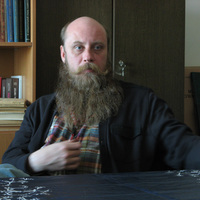Dissertation by Christopher T Riedel

Monastic Reform and Lay Religion in Æthelwold's Winchester
Bishop Æthelwold of Winchester (d. 984) was a reformer of Anglo-Saxon monasticism, but he was als... more Bishop Æthelwold of Winchester (d. 984) was a reformer of Anglo-Saxon monasticism, but he was also deeply concerned with the religion of ordinary English laypeople. Whether in his promulgation of the cult of saints, vast elaboration of the liturgy, or extensive rebuilding of Winchester’s churches, Æthelwold demonstrated an interest in the lay religion that has been consistently ignored by modern scholars who fixate on his monastic zeal. This concern for the laity is natural in the context of Æthelwold’s own interpretation of the English past, as his goal of an all-monastic English Church necessitated a pastoral role for his reformed monks rather than their strict seclusion from the world. Such a goal was possible because Æthelwold initiated his reform program in the mid tenth century, when corporate religious life still provided the bulk of pastoral care in Winchester and the rest of southwest England, and the organized parish system was only a dim possibility as small local churches began to appear haphazardly in the north and east of the country. Æthelwold’s reforms were therefore very different from similar ones taking place on the continent or even in the sees of his fellow English reformers, and he attempted to recreate an imagined English past very unlike the Church that would eventually result a century later. The influence of his students, however, especially Wulfstan Cantor and the prolific Ælfric of Eynsham, shows that Æthelwold’s unusual interest in lay religion had far reaching consequences for the medieval English Church.
Papers by Christopher T Riedel

Debating the Role of the Laity in the Hagiography of the Tenth-Century Anglo-Saxon Benedictine Reform
La Revue Bénédictine, 2017
The three central churchmen who directed the spread of reformed Benedictine monasticism in Englan... more The three central churchmen who directed the spread of reformed Benedictine monasticism in England in the second half of the tenth century were all subjects of hagiographies within a few years of their deaths in the 980s and 990s. These hagiographies, however, fail to agree on the nature of the monastic reforms carried out only a generation prior. The hagiographers of St Dunstan (c910-988), Archbishop of Canterbury, St Æthelwold (c904x9-984), Bishop of Winchester, and St Oswald (d992), Bishop of Worcester and Archbishop of York, writing in the 990s, had widely differing opinions about what qualities and interests were most important to their saintly subjects and by extension to the reform movement as a whole, especially when it came to lay religiosity.
Wulfstan Cantor, depicting the formidable Bishop Æthelwold, emphasizes that his saintly subject was a stern and zealous proponent of strict monasticism, but Wulfstan's portrait of Æthelwold when juxtaposed with the slightly later vitae of the other two reformers shows a keen interest in the religiosity of the laity unmatched in the other lives. In particular Byrhtferth of Ramsey's writings on Archbishop Oswald show that the last of the three hagiographers had little interest in the laity beyond their use in ritualized and formulaic depictions of the saint. Contrasting the very different portrayals of the interactions between the bishops and their lay congregations shows that the second generation of reformers, and perhaps even their saintly predecessors, had markedly differing attitudes towards their pastoral role in English society, which in turn should lead to a reevaluation of the unity and nature of this important era of religious reform.
The Catholic Historical Review, 2016
The author examines the Translation and Miracles of St. Swithun by the tenth-century monk Lantfre... more The author examines the Translation and Miracles of St. Swithun by the tenth-century monk Lantfred as a way of gauging the relationship of the laity to the reformist bishop Æthelwold and the monks of the Old Minster Cathedral in Winchester during the first generation of the Benedictine Reform in tenth century Anglo-Saxon England.
“Praising God Together: Monastic Reformers and Lay People in Tenth-Century Winchester,” The Catholic Historical Review 102, no. 2 (2016), 284-317.











Uploads
Dissertation by Christopher T Riedel
Papers by Christopher T Riedel
Wulfstan Cantor, depicting the formidable Bishop Æthelwold, emphasizes that his saintly subject was a stern and zealous proponent of strict monasticism, but Wulfstan's portrait of Æthelwold when juxtaposed with the slightly later vitae of the other two reformers shows a keen interest in the religiosity of the laity unmatched in the other lives. In particular Byrhtferth of Ramsey's writings on Archbishop Oswald show that the last of the three hagiographers had little interest in the laity beyond their use in ritualized and formulaic depictions of the saint. Contrasting the very different portrayals of the interactions between the bishops and their lay congregations shows that the second generation of reformers, and perhaps even their saintly predecessors, had markedly differing attitudes towards their pastoral role in English society, which in turn should lead to a reevaluation of the unity and nature of this important era of religious reform.
“Praising God Together: Monastic Reformers and Lay People in Tenth-Century Winchester,” The Catholic Historical Review 102, no. 2 (2016), 284-317.
Wulfstan Cantor, depicting the formidable Bishop Æthelwold, emphasizes that his saintly subject was a stern and zealous proponent of strict monasticism, but Wulfstan's portrait of Æthelwold when juxtaposed with the slightly later vitae of the other two reformers shows a keen interest in the religiosity of the laity unmatched in the other lives. In particular Byrhtferth of Ramsey's writings on Archbishop Oswald show that the last of the three hagiographers had little interest in the laity beyond their use in ritualized and formulaic depictions of the saint. Contrasting the very different portrayals of the interactions between the bishops and their lay congregations shows that the second generation of reformers, and perhaps even their saintly predecessors, had markedly differing attitudes towards their pastoral role in English society, which in turn should lead to a reevaluation of the unity and nature of this important era of religious reform.
“Praising God Together: Monastic Reformers and Lay People in Tenth-Century Winchester,” The Catholic Historical Review 102, no. 2 (2016), 284-317.